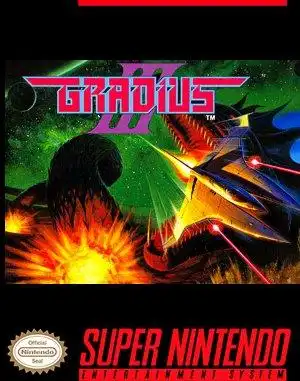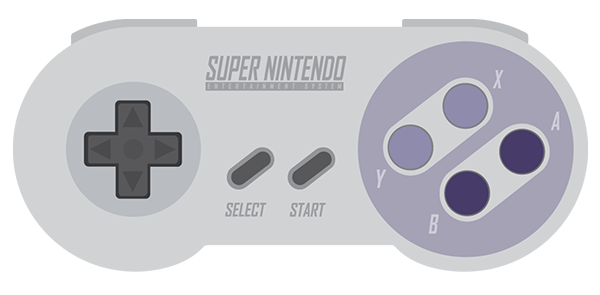Remember firing up your Super Nintendo, the purple buttons cool under your thumb, ready for a challenge? For many retro gamers, that challenge often came in the form of Gradius III SNES. Konami's sequel brought the intense arcade shooter action home, promising bigger bosses, more elaborate stages, and that signature power-up bar we all knew and loved (and sometimes cursed). But alongside the thrills came a few... peculiarities that defined the SNES port, particularly its legendary difficulty and its equally legendary slowdown.
Let's take a trip back to the 16-bit era and explore what made Gradius III on the Super Nintendo a memorable, if sometimes frustrating, experience for a generation of players.
A Sequel Arrives
Gradius III first hit arcades in 1989, following the path laid by its highly successful predecessors. When it arrived on the Super Nintendo in 1990 (a launch title in Japan!), it was a big deal. While the US missed out on an official NES release of Gradius II, the SNES port of III served as many Western players' first taste of the Gradius series beyond the original Gradius. It aimed to replicate the arcade intensity on home hardware, and mostly succeeded, albeit with some notable compromises and changes.
The Iconic Power-Up System
One of the defining features of the Gradius series is its unique power-up system. Instead of collecting distinct items, you grab 'power capsules' that move a cursor along a horizontal menu. Collecting enough capsules lets you activate the highlighted upgrade: Speed Up, Missile, Double, Laser, Option (the little helper ships!), and Shield.
The strategic depth comes from deciding when to activate an upgrade and which one to prioritize. Do you go for speed first to dodge bullets? Or stack Options for maximum firepower? Dying means losing all your hard-earned upgrades, sending you back to a checkpoint often severely underpowered – a mechanic that contributes heavily to the game's challenge.
The SNES version added a fantastic feature: the Edit Mode. Before starting, you could customize your power-up bar layout, even including some exclusive weapons not found in the arcade. This added significant replayability and allowed players to tailor their strategy, whether focusing on defense with the Reduce (makes your ship smaller) or unleashing unique firepower.
Gameplay: Stages, Bosses, and... The Slowdown
Gradius III on SNES features a diverse range of stages, from the classic volcanic and Moai levels to the memorable bubble stage and the high-speed zone. The level design is often creative and challenging, filled with unique environmental hazards and enemy patterns. The bosses are typically large and intimidating, requiring careful movement and focused fire.
However, we can't talk about Gradius III on SNES without addressing the slowdown. When the screen gets busy with enemies, projectiles, and explosions, the game's frame rate can plummet dramatically. For some, this was a frustrating technical flaw that made the game choppy. For others, it was a strange, almost helpful feature, giving them extra milliseconds to react to dense bullet patterns. Regardless of how you felt about it, the slowdown was an undeniable part of the Gradius III SNES experience.
Visuals and Sound
For an early SNES title, Gradius III looked pretty good. The sprites were detailed, the backgrounds offered layered scrolling effects (though some arcade visual flair was cut), and the colors were vibrant. While not pushing the absolute limits of the hardware, it was a clear step up from the 8-bit era.
The music, composed by Konami Kukeiha Club, is classic Gradius – energetic, catchy, and fitting for intense space battles. The sound effects are solid, providing satisfying feedback for shooting enemies and collecting capsules, though perhaps not as iconic as the music.
The Infamous Difficulty
Let's be clear: Gradius III on SNES is hard. Like, really, really hard. Even with the added continue feature (unlike the arcade), losing all your power-ups and being sent back to a checkpoint often feels like a death sentence. Enemy patterns are relentless, hazards are everywhere, and one wrong move can erase minutes of progress.
This difficulty, combined with the power-up loss penalty, is where the game truly tests a player's patience and skill. It's a game that demands memorization, precision, and often, a bit of luck. Many players relied heavily on the SNES's save state feature if playing on emulation or later ports like Virtual Console to make meaningful progress.
Arcade vs. SNES: Different Beasts
It's worth noting that the SNES version isn't a perfect port of the arcade game. Levels were changed or omitted, bosses were added or moved, and the overall balance shifted. The SNES version has a reputation for being more difficult in some ways due to the checkpoint system and power-up loss, even if the arcade had its own brand of brutal challenge (like the lack of continues). They are distinct experiences, each with its own quirks.
Playing Gradius III on SNES Today
If nostalgia is calling, how can you play Gradius III today?
- Original Hardware: Dust off your SNES and find a cartridge!
- Virtual Console: It was available on the Wii, Wii U, and New 3DS Virtual Consoles, though these platforms are becoming less accessible.
- Emulation: Playing via SNES emulators on PC or other devices is a popular option, allowing the use of save states to mitigate the difficulty somewhat. Sites like Archive.org often host playable browser versions (though performance can vary).
- Collections: Gradius III has appeared on various Konami collections over the years, often including the arcade version, sometimes the SNES port.
Final Thoughts
Gradius III on the Super Nintendo is a fascinating game. It's a beautiful, challenging, and often frustrating shmup that represents a significant step for the series on home consoles. Its power-up system and Edit Mode are brilliant, its levels are memorable, and its presentation holds up reasonably well.
Yes, the slowdown is real. Yes, it's incredibly difficult. But for those who grew up with it, or for retro enthusiasts looking for a true test of skill (and patience), Gradius III SNES remains a classic. It's a game that perfectly encapsulates the charm and the sometimes-rough edges of 16-bit gaming. Load up your Vic Viper, pick your power-up layout, and see if you still have what it takes to take down Bacterion!
Gradius III SNES FAQ
Q: Is Gradius III on SNES the same as the arcade version? A: No, the SNES version is an adaptation with changes to levels, bosses, difficulty balance, and the addition of the Edit Mode and continues.
Q: Why is Gradius III SNES so difficult? A: The game is hard due to relentless enemy patterns, environmental hazards, and the punishing system where you lose all power-ups upon death and restart from a checkpoint, often severely underpowered.
Q: What is the "slowdown" in Gradius III SNES? A: Slowdown occurs when there are too many sprites and effects on screen, causing the game's frame rate to drop significantly.
Q: Can I play Gradius III SNES on modern systems? A: Yes, through emulation, Virtual Console releases on older Nintendo platforms, or potentially on Konami retro collections.


